
Smart assistance with EzloPi!
Parking assistance using MB1013 sonar sensor
The EzloPi smart devices provide automation through simple, customizable use with our open-source EzloPi platform, making daily life easier and improving human-machine interactions.
Before moving into this example, it is very important to know about the device registration, provisioning and converting the ESP32 device into an EzloPi device along with knowledge of Web Flasher, MiOS Mobile Application for Android/iOS and the MiOS Web Application.
1. About this example
This project demonstrates the development of a parking assistance system using the MB1013 sonar sensor integrated with the EzloPi device. The sonar sensor will measure the distance between the vehicle and obstacles or the wall of the garage, providing real-time feedback to the driver by triggering the neon LED strip. The EzloPi device will process this data and trigger alerts, ensuring safe and precise parking. The system aims to enhance parking accuracy and reduce the risk of collisions in tight spaces.
2. Project Demonstration Video
Welcome to the project demonstration video section. The following video showcases the key aspects of Parking assistance using MB1013 sonar sensor, providing a visual walkthrough of its implementation.
3. Circuit Diagram & Interface
The following components are required for interfacing with the EzloPi device:
- ESP32 as an EzloPi smart device.
- MB1013 sonar sensor module.
- XY-MOS, high-power dual MOSFET driver module.
- 24-LED Mini portable lamp.
The wiring diagram of ESP32 30 pin is represented as follows:
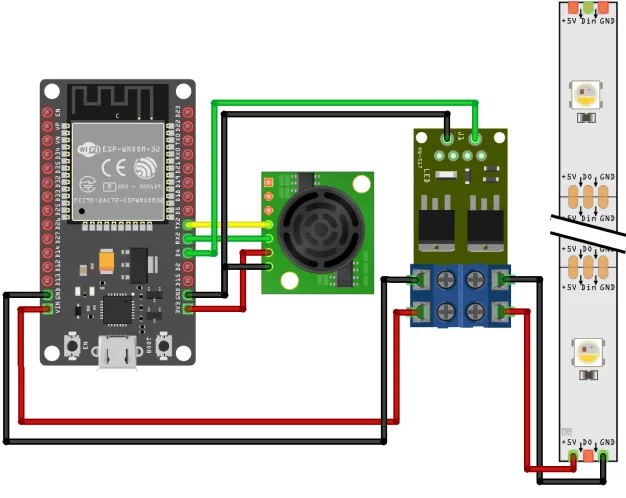

The following connections are made in order to complete the circuit setup.
From ESP32 to the MB1013 module:
| ESP32 | MB1013 |
| 3V3 | VCC |
| GND | GND |
| D16 (RX) | Tx |
| D17 (TX) | Rx |
From ESP32 to the MOSFET driver module:
| ESP32 | MOSFET driver module |
| D5 | Trig |
| GND | GND |
From MOSFET driver module to LED Strip:
| MOSFET Driver | LED Strip |
| OUT+ | 5V |
| OUT- | GND |
4. Interfacing the MB1013 Sonar sensor module using the EzloPi Web Flasher
1. Set up your device/hardware by visiting config.ezlopi.com

- Log in using the credentials which you just set earlier while signing up.
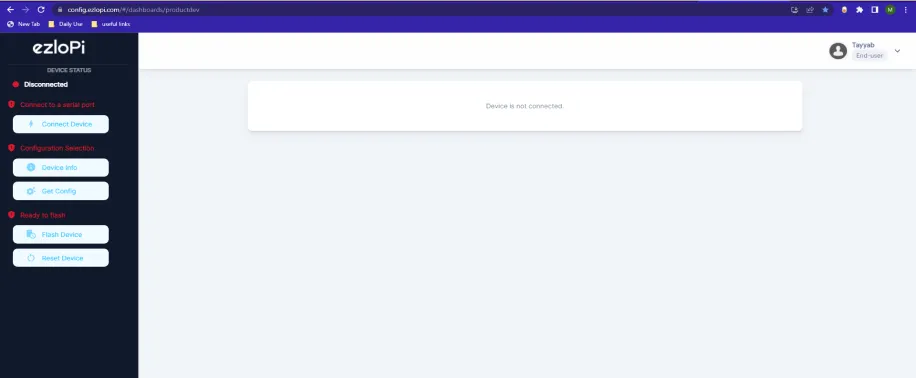
- Now, click on the Connect Device button and a pop-up window will appear.
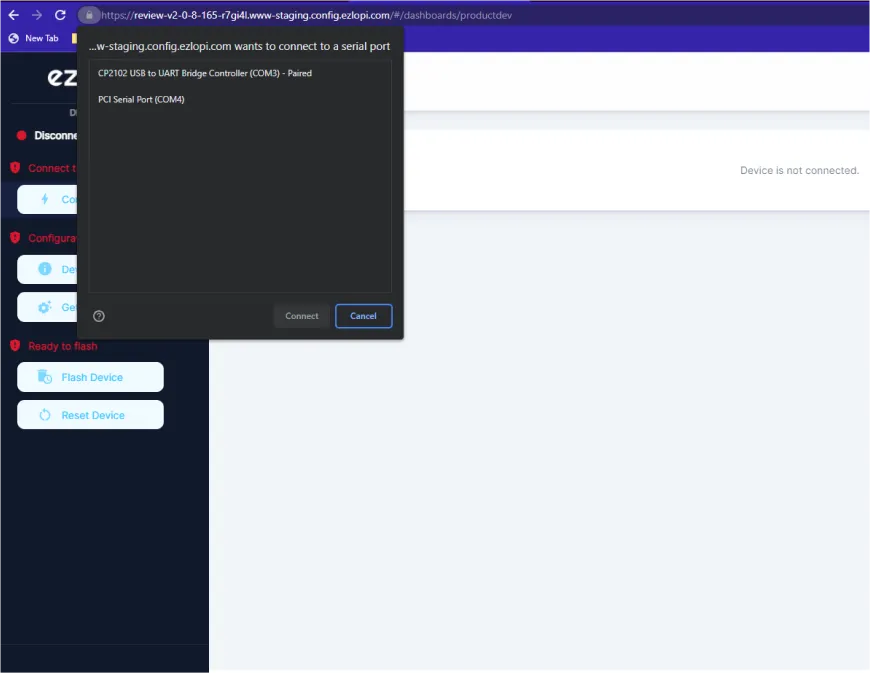
- Now, select COM Port to which your ESP32 device is connected. In our case, the COM3 port is used.
Click Connect
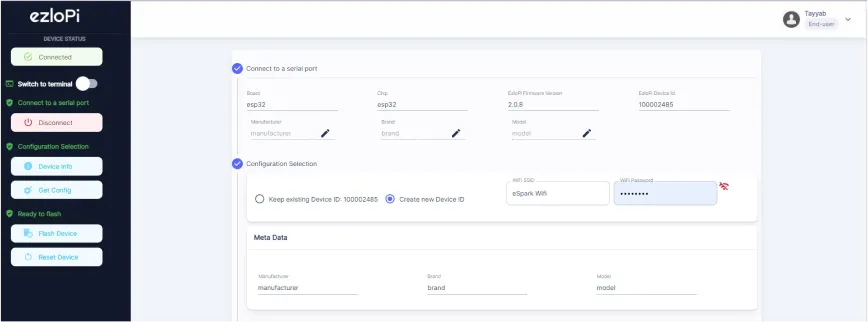
- If you are new to this and it's your first time configuring, select Create new Device ID. Enter Wifi SSID and Wifi Password.
- In the Device Configuration, tab click on UART.
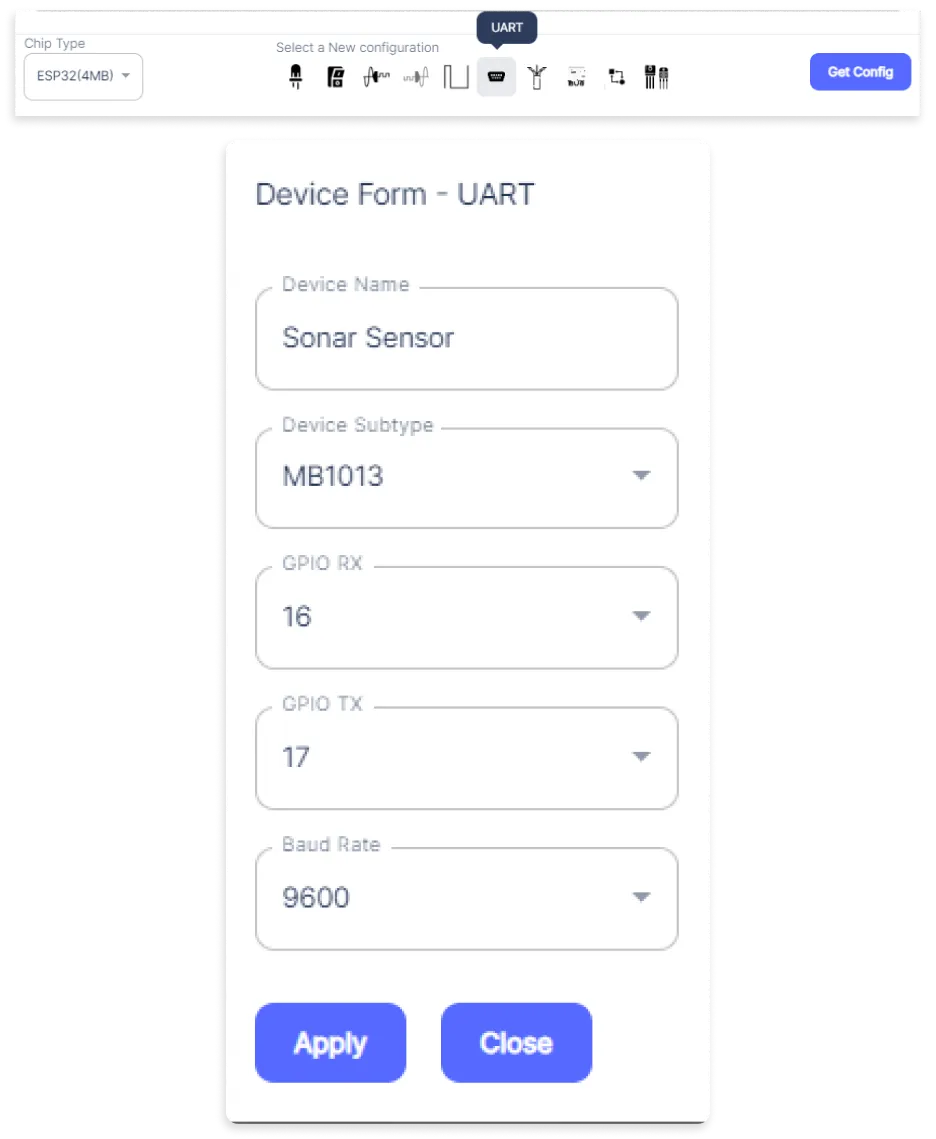
- A window will open for inputting the following parameters:
- Set a device name of your choosing. In our case, we set it to Sonar Sensor.
- Set Device subtype to MB1013.
- Set GPIO RX to 16.
- Set GPIO TX to 17.
- Set Baud Rate to 9600.
- Then Click Apply Button.
- In the Device Configuration, tab click on Digital Output.
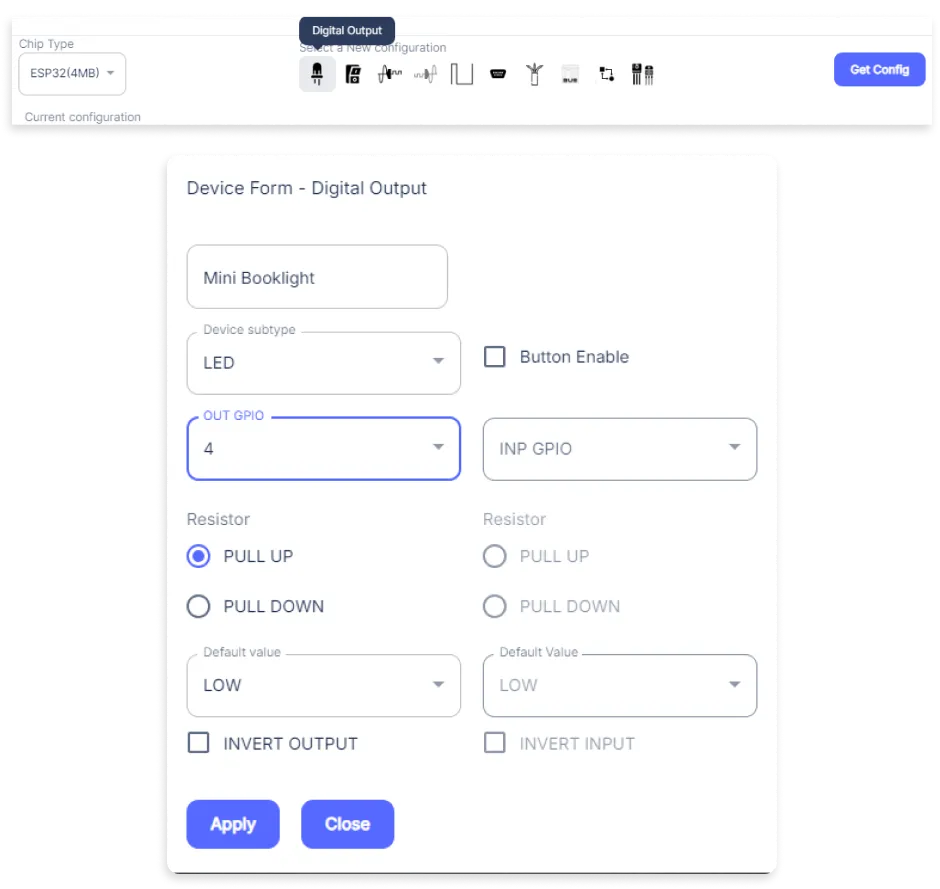
- Again click on Digital Output in the configuration tab. A Digital Output window opens for inputting the following parameters:
- Set a device name of your choosing. In our case, we set it to LED Strip.
- Set Device subtype to LED.
- Set OUT GPIO to 4.
- Set the Resistor to PULL UP.
- Then Click Apply Button.
- After clicking the apply button you can see a table of your setting in the device configuration tab.
- Press the Flash Device button.
- A window will appear on the bottom right side of the screen displaying “Please press BOOT button while flashing begins.”
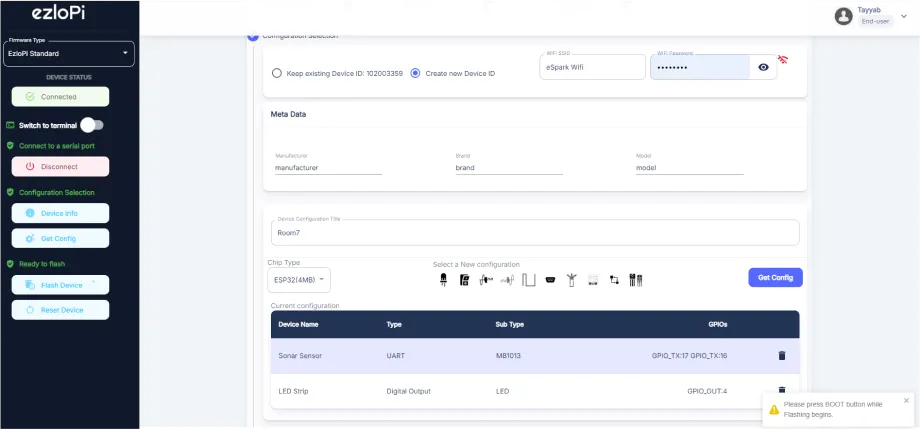
- Hold the BOOT button down until the next window appears on the bottom right side of the screen which says “Installation prepared. Please release the boot button now.”
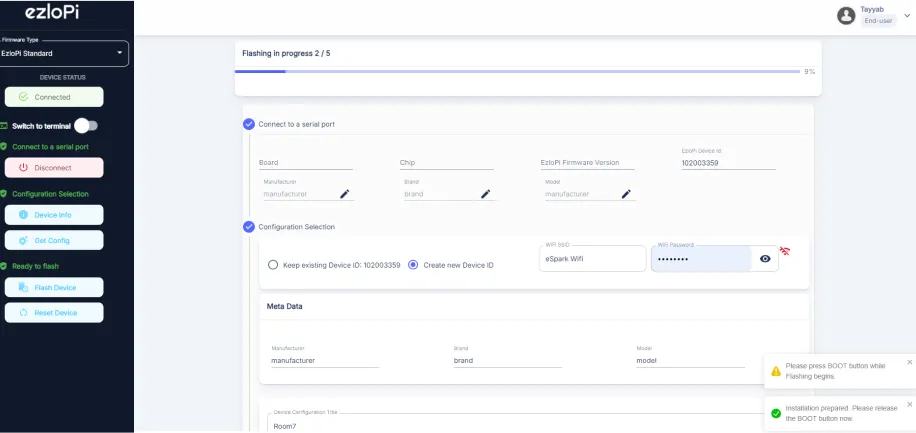
- Release the BOOT button from your ESP32 when this pop-up on the bottom right window appears.
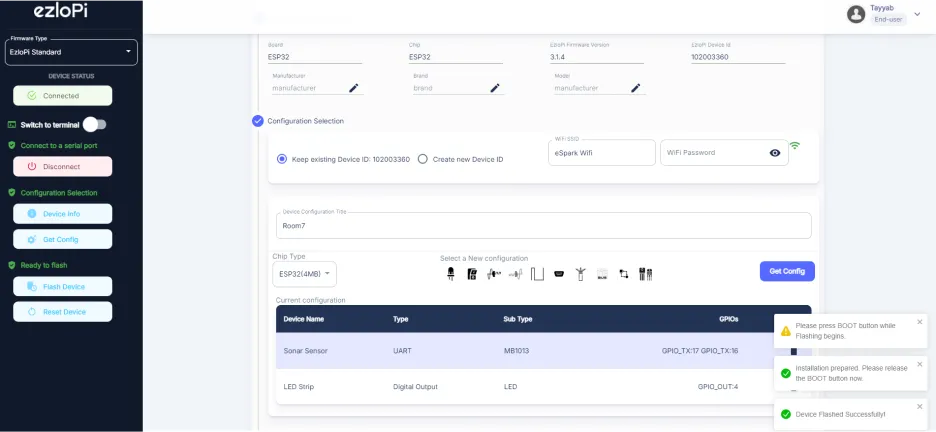
- After some time, a popup will appear saying Device Flashed Successfully! This means that your device has been set up successfully.
5. MiOS Web Dashboard
- After configuring the controller with the EzloPi web flasher, head to ezlogic.mios.com

- Use the same credential to log in that you used for configuring the controller with the web flasher.

- In the MiOS web dashboard, you will be able to see the tiles for the MB1013 sonar sensor and the Mini Booklight. These tiles will indicate the status of the mini book light depending on the output of the sonar sensor when it detects an obstacle or an object.
MeshBots:
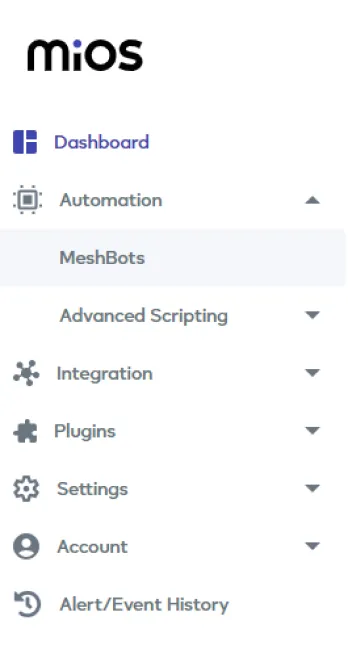
- On the left side of the screen under Automation, click on MeshBots.
- On meshbot screen, click on Create new MeshBot button present on the top right corner of the screen.
- After clicking on Create new MeshBot, you will see this now under Automation MeshBot click on EzloPi.
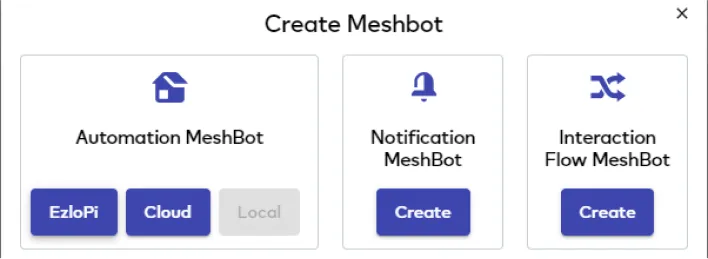
- On the next screen you will see that we can create a name of our choosing, in this case we write it as Test004.
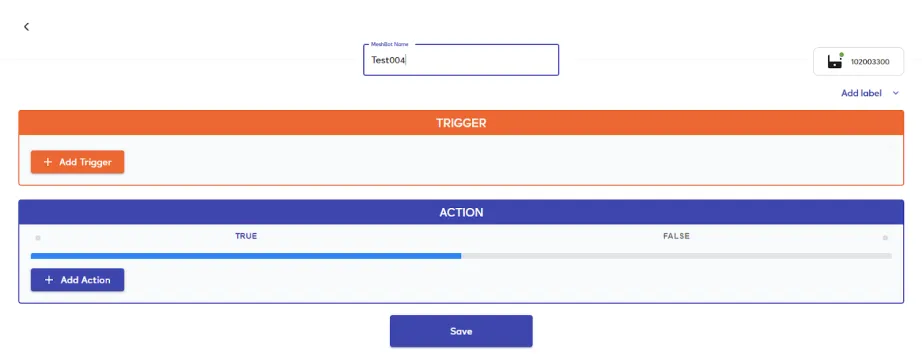
- In the trigger tab you can set the TRIGGER for your device and in the ACTION tab you can set the action to be performed based on the trigger which you have created.

- Set these things in TRIGGER section:
- Set Node Type to Device.
- Set the Node to SPDT Switch.
- Set the Capability to True.

- Set these values in the TRUE part of the ACTION section.
- Set Controllable Type to Device.
- Set the Controllable to Mini Booklight.
- Set the Capability to switch.
- Set the Value to true.
- Now Click the Save button.

- Set these values in the FALSE part of the ACTION section.
- Set Controllable Type to Device.
- Set the Controllable to Mini Booklight.
- Set the Capability to switch.
- Set the Value to false.
- Now Click the Save button.

- After clicking the save button you can see this screen on the top right corner of the screen.

- Here you can see your saved MeshBot. Now click on Dashboard.
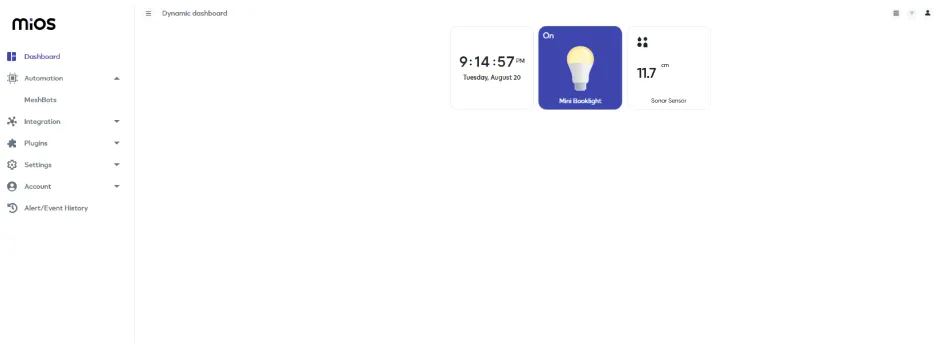
- Now, on the MiOS web dashboard, you can see that when the sonar sensor detects an obstacle or an object, the mini book light is turned ON because of the rules we have set in meshbot.
6. MiOS App
You can download the MIOS Android app from the Google Play Store and Apple App Store.
- After downloading the app, proceed to install the application and open it.

- Using the MIOS mobile application, create a new Ezlo Cloud account using the sign-up option. If you already have an account, you may proceed to log in.

- After successfully logging in, you will be able to see the number of controllers connected such as a lamp, fan, or any other device in the MiOS app. Tap on any controller of your desired ID:

- You will be able to see the status of your controller whether it is online or offline. Access the device dashboard, and tap the device. The following view of the dashboard will appear:
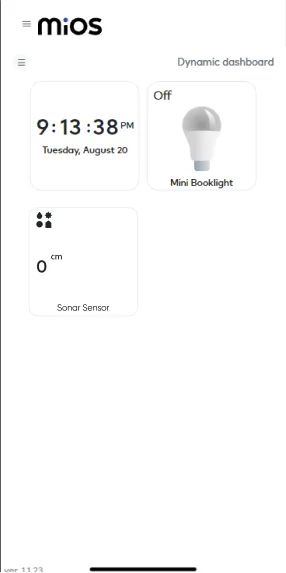
- In the MiOS web dashboard, you will be able to see the tiles for the MB1013 sonar sensor and the Mini Booklight. These tiles will indicate the status of the mini book light depending on the output of the sonar sensor when it detects an obstacle or an object.
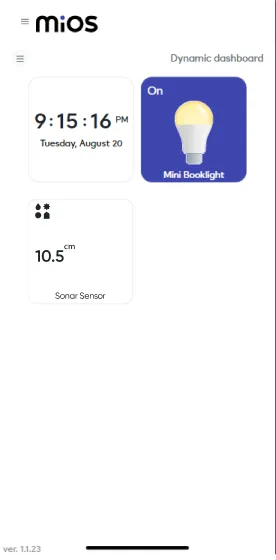
- Now, on the MiOS mobile dashboard, you can see that when the sonar sensor detects an obstacle or an object, the mini book light is turned ON because of the rules we have set in meshbot.

eZlopie Products A single-channel 5V relay module $00.00

eZlopie Products Momentary switch $00.00

eZlopie Products Level Shifter Module (BSS138) $00.00

eZlopie Products ESP32
$00.00

eZlopie Products AC Lamp and Holder
$00.00












